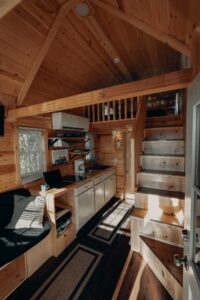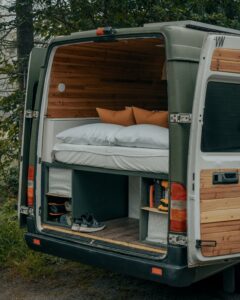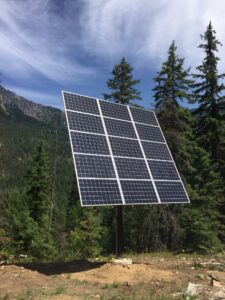Solar for Tiny Homes
Solar for Tiny Homes
Can solar provide power for my tiny home?
 Yes, it can! Solar works similarly for tiny homes as it does for the average home, but since you are working with a smaller space, some flexibility is necessary. Though space is a restricting factor, there are options available to you.
Yes, it can! Solar works similarly for tiny homes as it does for the average home, but since you are working with a smaller space, some flexibility is necessary. Though space is a restricting factor, there are options available to you.
Determine Your System Type
Will your tiny home be: Grid Tied? Off Grid? Or Grid Hybrid? This decision will affect many aspects of your system including the equipment that is needed.
Grid Tied
If you plan to be tied to the grid, your tiny home will need to be stationary or otherwise have consistent access to utility power. Grid tie solar provides the benefits of using the grid when your solar array isn’t producing power – at night or on dark, stormy days – while also reducing how much power you need to buy from your utility. You will not, however, have power during utility outages. Grid tie systems need less equipment than other types of solar power systems because you don’t need to store any power.
Grid Hybrid
Grid hybrid systems give you all the convenience of being on the grid, and lower electric bills, with the added peace of mind of having power during utility outages. A grid hybrid system requires room for storing extra equipment, mainly batteries. Your grid hybrid tiny home will need to be stationary or otherwise have consistent access to utility power.
Off Grid
Off grid systems require the most equipment of all the system types, because the entirety of the home’s power needs must be supplied by you. This means including more batteries, more solar panels, and/or a supplementary generator. For tiny homes consistently on the go, off grid is a great option as your location is not a limiting factor
Roof Mounted Solar for Tiny Homes On-The-Go
 Because of the smaller footprint and fewer occupants, the amount of power used in a tiny home is typically much less than other types of homes. But that doesn’t necessarily mean you can generate all the power from just a few solar panels. Which poses the question: How do solar panels fit into the picture?
Because of the smaller footprint and fewer occupants, the amount of power used in a tiny home is typically much less than other types of homes. But that doesn’t necessarily mean you can generate all the power from just a few solar panels. Which poses the question: How do solar panels fit into the picture?
If your tiny home is mobile, a roof mounted system makes the most sense because your solar panels easily travel with you from location to location. But because tiny homes have very limited roof space, you’ll have to use very little power since you will likely only have space for 2-3 solar panels. Depending on the wattage of solar panels available at the time of purchase, that would mean somewhere in range of 900 – 1,400 watts. If this is all the power you need, roof mounted panels are a great way to use your tiny home roof space.
Sufficient solar panel production greatly depends on the location, array direction, and tilt angle of the array. To ensure maximum production, your tiny home should be parked in an open space away from any possible shading with the panels facing south (for the northern hemisphere) and tilted to a desirable angle if possible. You may also want to consider solar racking or mounts that can be adjusted to different angles, allowing you to adjust the tilt of your solar panels to achieve an optimum solar exposure.
And don’t forget that if your solar panels are on the roof, you will need to calculate any wind load during transit so you don’t lose your solar panels while moving your tiny home.
Ground Mounted Solar for Stationary Tiny Homes
 If your tiny home is stationary, you might want to consider a ground mount for your solar array. Ground mounts allow you to have a larger solar array that could cover your entire home’s power usage. A ground mounted system could be as little or as big as you need, and you could place it wherever you have the space. It can also be placed where the array would achieve the most amount of solar throughout the day. Other benefits include: the ability to easily clean the panels, adjust the angle and tilt, and clear snow or perform other maintenance with ease, and being able to locate your tiny home amongst trees or other places where the roof will get shaded.
If your tiny home is stationary, you might want to consider a ground mount for your solar array. Ground mounts allow you to have a larger solar array that could cover your entire home’s power usage. A ground mounted system could be as little or as big as you need, and you could place it wherever you have the space. It can also be placed where the array would achieve the most amount of solar throughout the day. Other benefits include: the ability to easily clean the panels, adjust the angle and tilt, and clear snow or perform other maintenance with ease, and being able to locate your tiny home amongst trees or other places where the roof will get shaded.
Grounding
Proper grounding is critical to the safety of all solar applications, stationary or mobile. Since many mobile applications are constantly on the go, there can’t be an earth ground rod physically inserted into the ground. A simple solution is to make sure you have the proper inverter for your application. Mobile inverters provide proper grounding isolation for when you are both stationary and in transit.
Designing Your Tiny Home for Solar
It is always more cost effective to increase your energy efficiency than it is to produce more electricity to compensate for low efficiency electric appliances. But in a tiny home the added benefit of being energy efficient is needing less space for your solar power system. Choosing energy efficient and electricity alternative appliances are key will help keep your power needs low. Here are some ways that you can design your tiny home to be more energy efficient:
Sizing Your Tiny Home System
The steps are similar to sizing any solar power system, except you won’t have any historical power bills to help:
Make a comprehensive list of your electric loads – all of the items you plan to power in your tiny home. Just remember that the more power you use, the more you will need to produce. It is important to think of every light and appliance and tool that you may need throughout the year. Don’t forget any well or septic pumps if you won’t be on city water. Our load sizing calculator can will help with your power use calculations.
- For the most accurate calculations, refer to the wattage label on each appliance or piece of equipment and estimate the amount of time you will use them each day, then do some math. For some items (like cell phones and laptops), it is reasonable to use a guesstimate. But larger appliances that have higher power consumption or that are in use frequently, and that vary significantly from one model to another, using the actual electrical load ratings is important.
- Determine your area’s average sun hours. You will want to park or place your tiny house in an area with southern exposure. Then you will use the annual average sun hours in your area so that you can adequately size your system for winter months where less solar is available. To find the average sun hours in your area, refer to the National Renewable Energy Laboratory’s (NREL) solar insolation map. Or use NREL’s PV Watts calculator for even more information about what to expect from a solar power system in your area. If your tiny home will be mobile, keep in mind that you may be able to use campgrounds for temporary power or keep a backup generator on hand.
- Consider the weight and size of your system components. The main components of a system including the solar panels, batteries, and inverter(s) all add up in size and weight. If stationary, the solar panels can be placed on a mount outside and you can build an enclosure to house the batteries and inverter(s) which can save space. On the other hand, if your tiny home will be mobile, you may need to further limit your power usage or find specific components that will not take up too much space or add too much weight.
- Once you know how much power you use and the realm of your weight and size limitations, you can proceed to size your solar PV system. If your tiny home is off-grid, it is critical the system is properly sized because you will not have utility power to draw from if your power system doesn’t provide enough to meet demand. That is why we recommend getting professional help from an expert off-grid system designer, so you can be sure that you have all the power you need when you need it.

